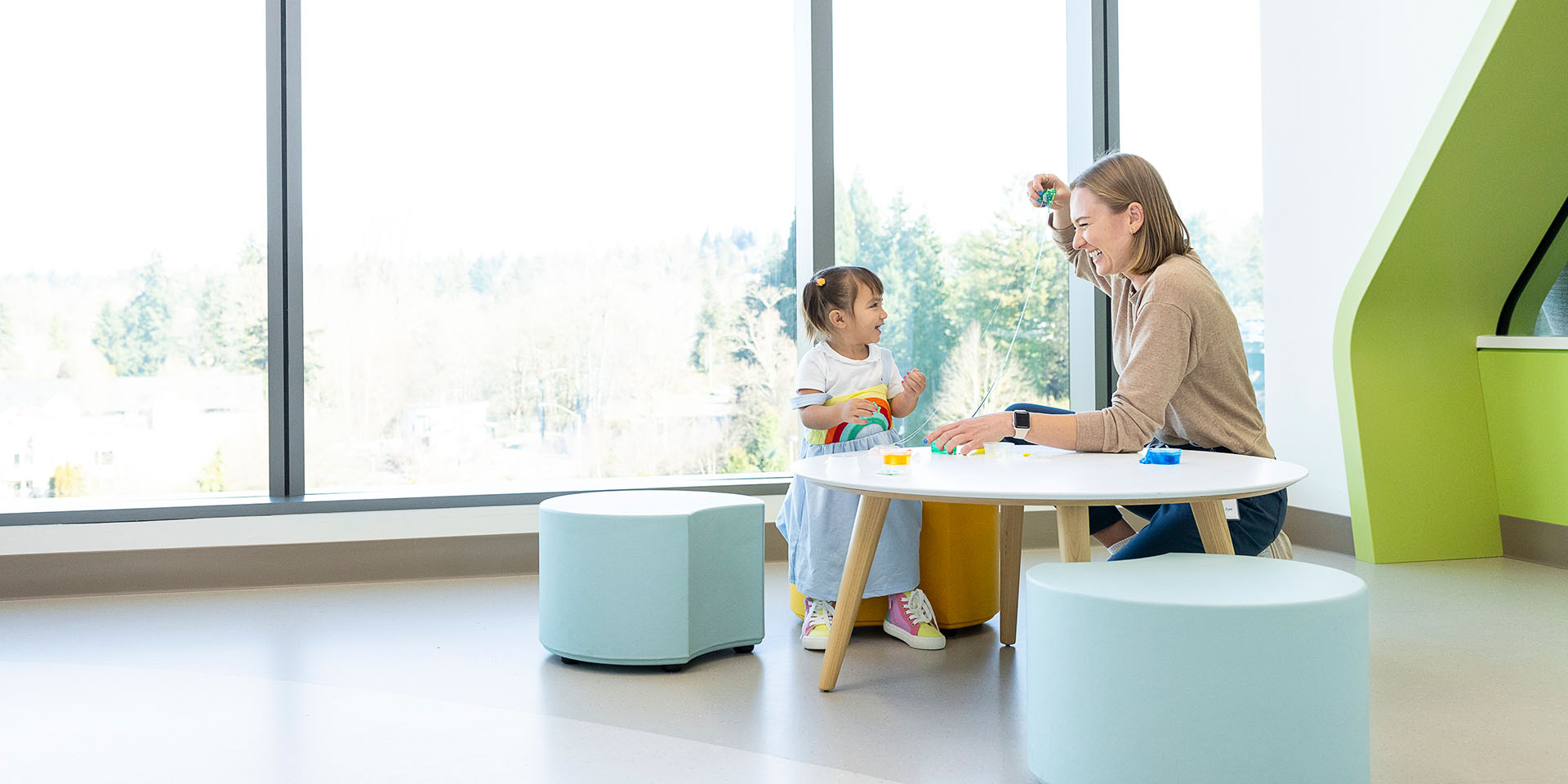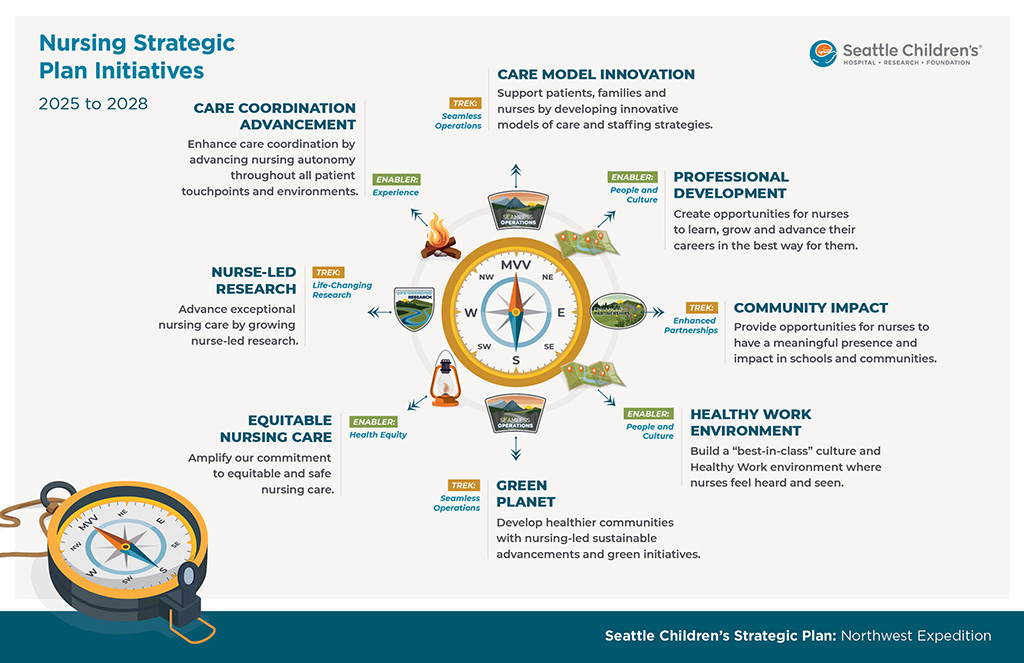
Nursing Annual Report
Read the 2024 Nursing Annual Report to discover how our incredible nurses increased access to services, supported their colleagues and provided life-changing hope, care and cures.

Care Across the Continuum
We will improve the continuity of care across the healthcare settings where our patients receive care — in the community, hospital and ambulatory settings.
- At the beginning of 2024, Seattle Children’s 32-bed NICU was consistently full, which meant:
- Emergency beds were the only available admitting beds for neonates.
- Neonates needing to come to the NICU would be placed on community holds and triaged for admission based on degree of acuity.
- Patients in the NICU are some of the most vulnerable that Seattle Children’s cares for, so adding space specifically for their needs was critical.
- In November 2024, 16 medical rooms were converted to NICU beds.
- Multidisciplinary teams were involved in all phases of the renovation process.
- Nurses and certified nursing assistants planned for adjusted workflow, advised on equipment configuration and utilized checklists to ensure room readiness.
- Nurses designed and implemented mock codes and scenarios. They collaborate on solutions to recognize challenges.
Community and Connection
We will value the uniqueness of each patient, family member, and colleague, and work to meet their individual needs.
- “Own Your Impact: Charge Nurse Incivility Training” was created by Nursing Professional Development Practitioner Barbara Winters, DNP, RN, with support from Juliette Ofamen, RN, Nurse Consultant, to provide charge nurses and other nurse leaders with actionable information on how to help coworkers deal with incidents of bullying.
- The training was based on internal data from the disruptive behavior check-ins; a Shared Governance Council survey; Seattle Children’s nurse turnover data; and also evidence-based literature from outside sources.
- Preliminary data indicate that the percentage of nurse leaders who felt they had adequate knowledge regarding how to help coworkers who are victims of bullying rose from 52% to 95% because of this training.
- In 2024, the training was rolled out to over 200 full time charge nurses and over 60 nurse leaders.
- In 2024, Seattle Children’s Surgical Unit completed a project that placed the LanguageLine application on all Rover phones to provide nurses with an additional way to access video interpretation on demand.
- The project was so successful that Clinical Nurse Specialist Angela Turner, DNP, ARNP-CS, worked with Nursing Informatics to place the LanguageLine application on all Rover phones across all departments.
Mental and Behavioral Health
We will increase our ability to care for our patients’ mental health needs.
- Psychiatry and Behavioral Medicine Unit (PMBU) nurses are now trained in the Ukeru technique.
- Ukeru is a trauma-informed crisis management approach that utilizes blocking pads to absorb a patient’s energy while in crisis, reducing the likelihood of restraint use and providing comfort care over control for patients in crisis while keeping staff safety at the forefront.
- This intervention, along with the new intervention to overcome barriers to patient discharge, has contributed to a 17% reduction in median length of stay on the PBMU.
- Along with the new individualized behavioral support policy, it has also contributed to a 22% reduction in violent restraint duration per 1,000 patient hours on the PBMU.
- In response to patients experiencing barriers to discharge after being clinically cleared, nurses (among others) advocated for a way to track “stalled” patients and initiated discharge interventions to help reduce unnecessary days in the hospital.
- An Epic report was generated that informs how to proceed in the discharge process for boarding/admitted patients clinically cleared for discharge but experiencing barriers
- to discharge, such as lack of residential facilities, parent/caregiver resistance, etc.
- This intervention, along with the introduction of the Ukeru crisis management approach, has contributed to a 17% reduction in median length of stay on the PBMU.
- PBMU nursing spearheaded the development of a behavior plans policy to provide safe and effective care to patients who need individualized behavioral support during procedures, ambulatory care, emergency department visits and inpatient admissions.
- The new approach to care is designed to foster collaboration that enhances patient and staff safety and honors the knowledge and expertise of each member of the healthcare team.
- A job aid was developed outlining how to initiate a behavior plan in Epic with distinct role responsibilities and standardized templates for 3 discrete behavior plans.
- This intervention, along with the introduction of the Ukeru crisis management approach, has contributed to a 22% reduction in violent restraint duration per 1,000 patient hours on the PBMU.
- PBMU and Emergency Department (ED) nurses redefined the model of care for mental and behavioral health in the ED (due to the volume and acuity of kids seeking ED care for mental and behavioral health concerns), resulting in the “Frequently Visiting Kids” project.
- This project:
- Defined “high utilizers” of the PBMU/ED for mental and behavioral health care needs.
- Ensured every patient has a behavior plan in place.
- Standardized a handoff checklist.
- Reset expectations that caregivers need to be involved in care to the best of their ability.
- Has contributed to a 19% reduction in median length of stay for ED mental health patients.

Staff Support and Wellness
We will create and maintain a safe and healthy work environment.
- In January 2024, Seattle Children’s was accepted into the AACN HWE collaborative. This 2-year collaborative began in April 2024 and will end in May 2026.
- The goal of the collaborative is to support organizations’ implementation of the AACN framework to create an HWE across organizations. The collaborative includes monthly meetings to learn from each other and receive guidance in implementing projects to create a healthier work environment.
- 45 hospitals, 12 of which are pediatric hospitals, are participating in the collaborative.
- Outcomes are measured through the administration of the HWE survey every 6 months starting May 2024 and tracking of data such as patient outcomes and staff turnover.
- Seattle Children’s Cancer and Blood Disorders (CBDC), Pediatric Intensive Care Unit (PICU), Surgical Unit and Inpatient Units represent Seattle Children’s in the collaborative. Each unit chooses a primary goal to work on over the 2 years, and the hospital chooses 1 overarching goal. The goals are based on the outcomes of the HWE survey. Goals:
- CBDC: Decrease staff reporting verbal abuse by patients and families by 5% or more by May 2026.
- PICU: Improve RN retention and decrease turnover by 1% by May 2026.
- Surgical Unit: Improve nursing retention and decrease resident RN turnover by 1% by May 2026.
- Overarching goal: Improve hospital-wide HWE survey results related to communication and collaboration by 10% by May 2026.
- 5 CICU nurses joined the AACN HWE CSI year-long program and started a peer- to-peer support program to impact unit culture, turnover and sick calls in the CICU.
- Once a week, a clinical nurse rounds for 8 hours, from 3 - 11 p.m., to connect with day and night shift nurses.
- The program uses scores from the Healthy Work Environment Assessment Tool (HWEAT) and Burnout Assessment Tool (BAT) to focus attention to needs.
- The team offers debriefing, therapeutic conversations and support, and escalates issues and concerns to CICU leadership.
- The program achieved a 25.77% decrease in turnover rate (12 month rolling turnover rate) in the CICU within 6 months of implementation.
- Co-led by Mary Field, DNP, RN, Senior Director, Nursing Innovation and Strategic Initiatives, the Workplace Violence Prevention Program pulled together many resources that already existed across Seattle Children’s and restated the organization’s commitment to preventing workplace violence.
- Reinstated and/or added new program components:
- Accurate reporting
- Effective support teams
- Ongoing prevention program evaluation
- Reinforcing connected policies
- Resisting normalizing workplace violence
- Thorough and equitable investigations
- Work completed in 2024:
- Published multiple policies
- Established data tracking pathways
- Created updated patient-facing signs
Looking Ahead: Nursing Strategic Plan 2025-2028
- In February 2024, an oversight committee of clinical nurses and nurse leaders as established to spearhead development of Seattle Children’s next 4-year nursing strategic plan.
- Nurses across the organization provided 929 ideas, which were grouped into 44 broad categories. Through additional work with the committee, 17 of those categories were included in what became 8 final initiatives.
- The initiatives were well balanced with 3 focused on patient/clinical, 3 on nurse/work environment and 2 on community.
- In September 2024, 62 clinical and leadership nurses attended a full-day retreat to identify specific projects to move forward across this 4-year (2025-2028) plan. Between 4 and 9 projects were identified for each initiative that will be implemented over the 4 years of the plan.

Explore Our Past Reports
Working at Seattle Children’s
To reach our goals, we are committed to recruiting and retaining the best nurses. We invite you to search our current job openings.
Seattle Children’s provides opportunities for our nurses to learn and grow in an innovative environment while being in full partnership with other providers on multidisciplinary teams. We support and engage our nursing staff with training and educational opportunities, state-of-the-art-facilities and equipment, shared governance and comprehensive benefits.
When hiring, we look for nurses who share our passion for family-centered care and who practice at the top of their profession. Whether you are a new nursing graduate eager to participate in our healing environment, or a seasoned professional committed to advancing the practice of nursing, we welcome your application.
